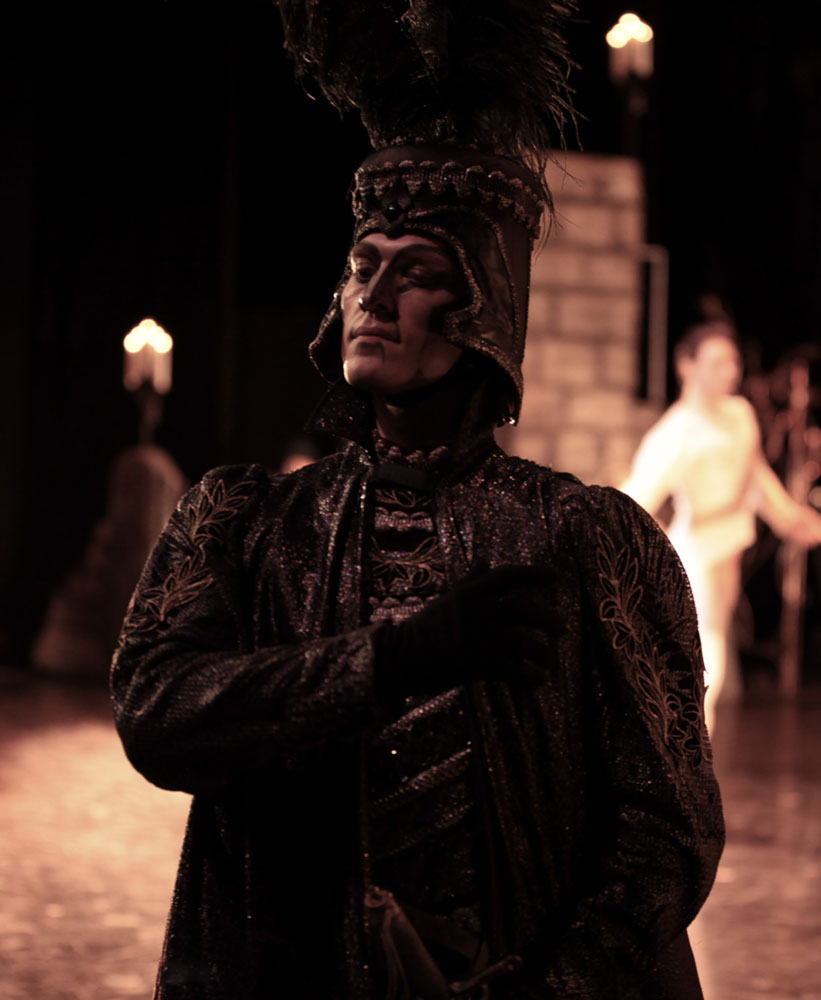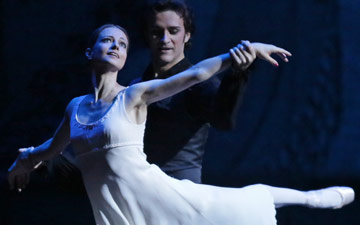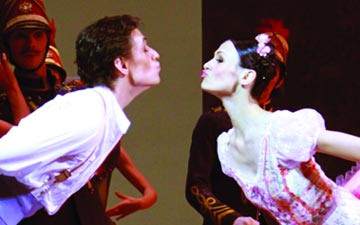
Moscow Kremlin Ballet
Swan Lake
Athens, Megaron Concert Hall
16-18 December 2011
“What we need is culture!” seems an oxymoron when said by an Athenian. But these words were passionately stated, in fact almost shouted at me, by a sixty-something Greek balletomane and doctor, bearing gifts of chocolate as he waited to pay homage to the dancers backstage. He was far from alone and culture – at least in the pure form of classical tutu’ed ballet – provided Athens with a very different kind of White Christmas from the one Bing Crosby dreamed about.
I saw the first five of 20 performances, which ran from 15 to 30 December (including Christmas Day) in the 1600-seater Megaron Concert Hall: three were sold out with the other two at 95% capacity, and this pattern was maintained throughout the run.
The idea behind the season is simple. Take a decent company – in this case, the Moscow Kremlin Ballet – with a strong classical base, a good cohort of soloists and an effective corps de ballet but without world-famous principals and add the latter as a string of guest couples from the best ballet companies around the world. Give them the word’s favourite ballet to dance and people will come even when their economy is more Rothbart than Rothschild.
The Swan Lake being performed was a largely traditional Ivanov /Petipa version with new choreography from the Kremlin Ballet’s veteran Artistic Director, Andrei Petrov inserted into Acts 1 (dating back to 1995) and 4 (newly added in 2010 to replace the company’s original fourth act, choreographed by Asaf Messerer). This later addition was a special delight, with a magical opening kaleidoscope of revolving, interleaving patterns, giving a special visual impact to the mystery of Tchaikovsky’s music. Petrov begins the second lakeside scene with the quartet of cygnets before allowing it to multiply into the full ensemble. His swirling, romantic choreography has these spectral white goddesses gently twisting one way and then the other, sometimes as circles within circles, their arms flowing in complete unison; and always flavoured with subtle references back to the choreography of Act 2. The Kremlin corps de ballet improved from good to excellent across these first five shows, culminating in a performance of such symmetry that it seemed digitally enhanced.
For a travelling troupe, the set was surprisingly robust with a basic infrastructure that served castle courtyard, lakeside and great hall without the need for any elaborate scenery-shifting. Allowing for the anachronisms of candles and chandeliers out by the lake, it was surprisingly effective for these multiple purposes. Less creditable was a lack of attention to detail with moulted feathers not cleared away from the stage during the interval between Acts 2 and 3. I especially liked Petrov’s device of opening and closing the performance by having “candles” lit around the stage.

© David Makhateli. (Click image for larger version)
Not all of the Petrovian innovations suited these Athenian arrangements however. In the Kremlin interpretation, the Act 1 pas de trois extends into a second dance (with Prince Siegfried partnering the same two girls) performed to the music usually occupied by the Prince’s melancholic solo. Given insufficient time for any of the Guest Principals to learn or rehearse the choreography, the extra pas de trois became an additional task for the Prince’s friend, Benno. While understanding the pragmatism it makes no sense whatsoever for Benno to be dancing with two young women to music that should provide an insight into the Prince’s psychological state.
Soloist roles were danced by the same cast throughout all 20 shows and the pas de trois was danced inconsistently over the five performances I witnessed by Egor Motuzov (as Benno), Natalia Balakhnicheva and Alia Khasenova. Motuzov always delivered a fine diagonal of initial jumps (I would lay money on the fact that he is a regular Bluebird) but often ran out of steam in the second part of his variation. The two girls also gave performances of variable quality with the consistent flaw across the quintet of shows that I saw being that one of the three was always off. It might be fairer to add, however, that the girls also danced as big swans and princesses, which meant that they were rarely off-stage throughout any of the 20 shows – a truly remarkable test of stamina and costume!

© David Makhateli. (Click image for larger version)
Mikhail Martniuk never flagged in the explosive virtuosity of the Jester but, in addition to the big tricks, he brought a notable range of subtle expressiveness to develop an understanding of the Prince and his court. I was also impressed by the consistency of Kiril Yermolenko’s work as Rothbart and the fact that he made the sorcerer seem both evil and powerful, a combination that is often under-achieved. As the Queen, Ekaterina Khristoforova achieved a similar double whammy in her motherly majesty.
Before assessing the brace of Guest Principal couplings, let me conclude the host team review by speaking of the performances by Alexandra Timofeeva and Maxim Afanasief in the principal roles (they took six of the matinee performances). Timofeeva has huge potential, possessing all the natural attributes and technique for an impressive white swan and a fierce drive to convey the duplicity of Odile while maintaining a sufficiently convincing imitation of Odette to fool the lovelorn Prince. It was a pity that she did not have a Siegfried to match: Afanasief was a late replacement for the advertised dancer (Aydar Shaydulin) and while every bit the prince in demeanour he appeared to be very much an apprentice in terms of dramatic impact with dancing too often punctuated by glitches.
I realised with some shock that the last time Johan Kobborg performed a pirouette on a stage was here in Athens, last September, (performing ’Giselle’ with Alina Cojocaru). It is more than simply ironic that I spent 16 hours on a plane in two return trips to Greece to see consecutive performances, albeit three months apart, by the Royal Ballet’s senior male principal. On this occasion his partner was Roberta Marquez and their opening night was incredibly appreciated by a full house calling them back for repeated bouts of applause more frequently than would be customary in Covent Garden. In truth, they were workmanlike rather than spectacular performances. Kobborg’s stagecraft is never short of being exceptional even when it is on automatic pilot and, here, one suspects that this was needed both to combat a nasty virus and so that he could focus his full attention on yet another unfamiliar production of a very familiar ballet. It occurred to me many times, watching Johan and – to a lesser extent – Roberta, that they were hearing music that has been a leit motif to their lives but, here, often having to cope with doing completely alien movements to that music.

© David Makhateli. (Click image for larger version)
One of the fascinations of seeing three casts of principals was to see how differently each pair tackled the white swan adagio and the black swan pas de deux. There was, for example, unsurprisingly a strong mime content to the Kobborg/Marquez performances and barely any mime at all in the show by the Mariinsky’s Alina Somova and Yevgeny Ivanchenko. Ivanchenko – now, like Kobborg, in the twilight of a great career – is an excellent partner; strong, attentive and without exception presenting the ballerina to the best effect. And Somova’s best effect is terrific. If not the best white swan in the world, she must be very near that summit: the look, the line, the ease of her balances and extensions and her fragile beauty are all qualities that Somova just has in abundance. Always a truly wonderful Odette (and getting better by the performance) she has developed the black side by retaining all these Odettian qualities and then giving them the blast of a blow torch and jet pack. Somova is going to become one of the world’s greatest dancers within a very few years and it is a great honour to have been able to watch the progress of her early career.
This special Swan-White Christmas was just the cultural fix that the Athenian Doctor had ordered and it’s nice to know that he and thousands of others found a welcome present in these performances promoted by Elva Events and David Makhateli (who danced with Tamara Rojo in a later cast). Next Christmas the Moscow Kremlin marathon will be back again at the Megaron to awaken The Sleeping Beauty in Athens.

















You must be logged in to post a comment.